WD Black SN750 SSD Review: A Not so Fresh Refresh (Updated)
WD's new Black SN750 offers a surprisingly good performance upgrade through firmware and software tweaks.
Why you can trust Tom's Hardware
Comparison Products for 2TB WD Black SN750
We tested the 2TB WD Black SN750 against the best SSDs on the market. We included Sabrent’s Rocket NVMe 4.0 with the PCIe 4.0 interface, and also threw in Intel’s Optane SSD 905P with its outrageous price tag but insanely-responsive XPoint memory. The Samsung 970 Pro, which maxes out at 1TB, also made the list along with the 2TB Samsung EVO Plus. Adata’s XPG SX8200 Pro and Patriot’s Viper VPR100 slot in as lower-cost alternatives that also feature competitive performance. Finally, we added in Intel’s 660p, a cheaper entry-level QLC NVMe SSD, as well as two SATA drives, the Crucial MX500 and WD Black HDD, for good measure.
Game Scene Loading - Final Fantasy XIV
Final Fantasy XIV Stormbringer free real-world game benchmark that easily and accurately compares game load times without the inaccuracy of using a stopwatch.
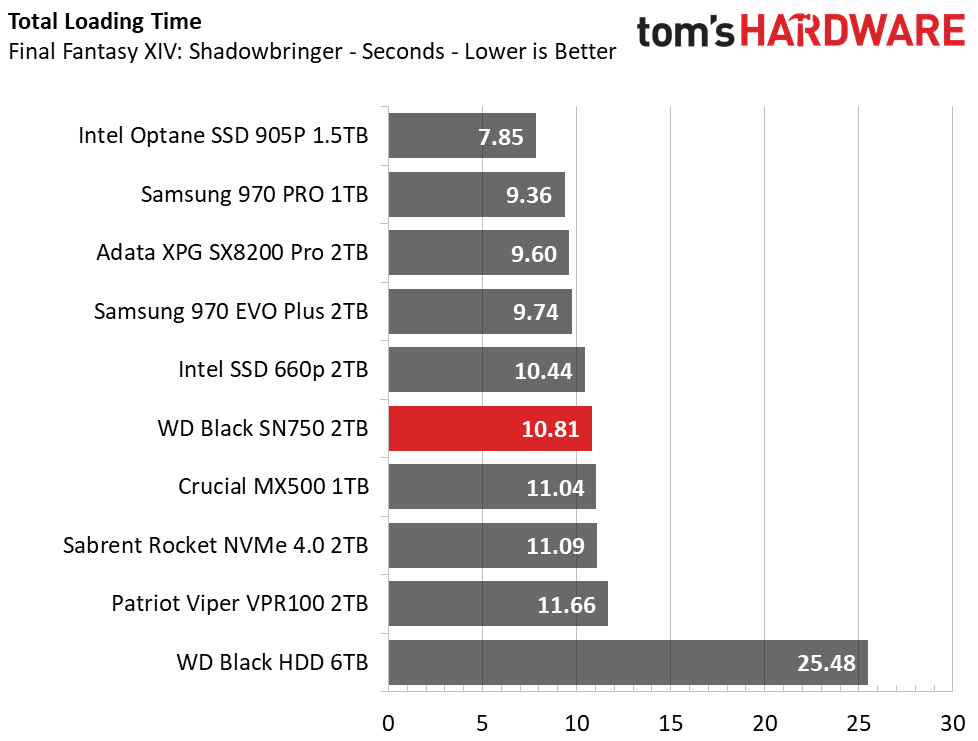
WD’s Black SN750 delivers fast game load times in whatever game you choose to play. But, as seen by its sixth place ranking, it isn’t the fastest option. Samsung’s SSDs both load faster by a few seconds, but Adata’s lower-cost XPG SX8200 Pro is just as competitive. Intel’s Optane 905P has the fastest performance in most applications, but the cheaper SSD 660p is also very competitive and beats even the high-end WD Black SN750.
Transfer Rates – DiskBench
We use the DiskBench storage benchmarking tool to test file transfer performance with our own custom blocks of data. Our 50GB data set includes 31,227 files of various types, like pictures, PDFs, and videos. Our 100GB includes 22,579 files with 50GB of them being large movies. We copy the data sets to new folders and then follow-up with a reading test of a newly written 6.5GB zip file and 15GB movie file.
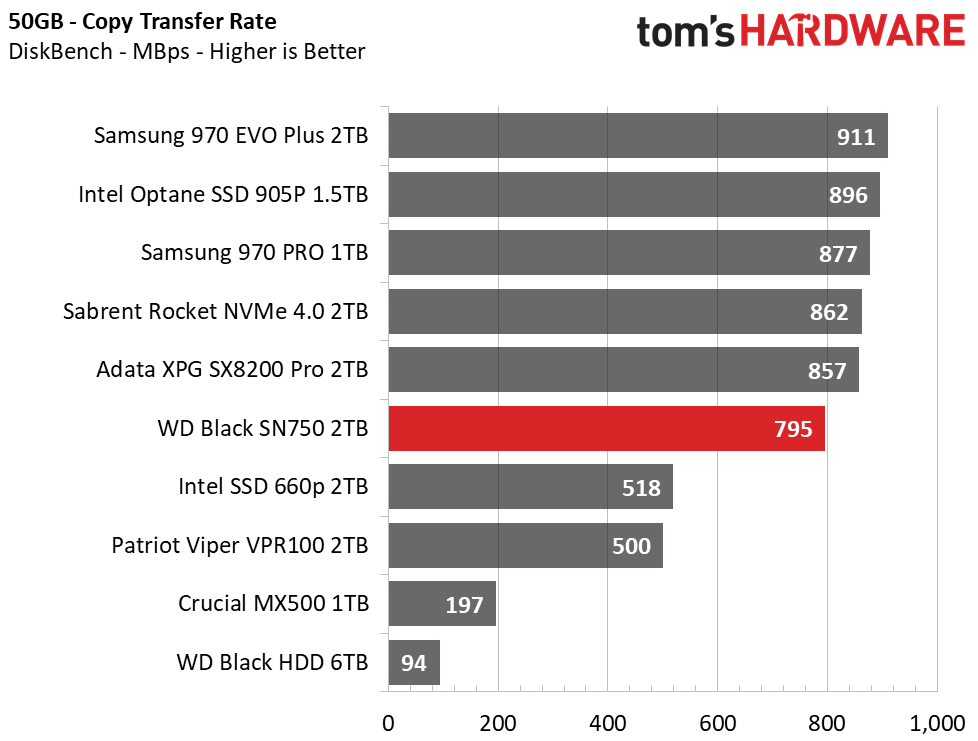
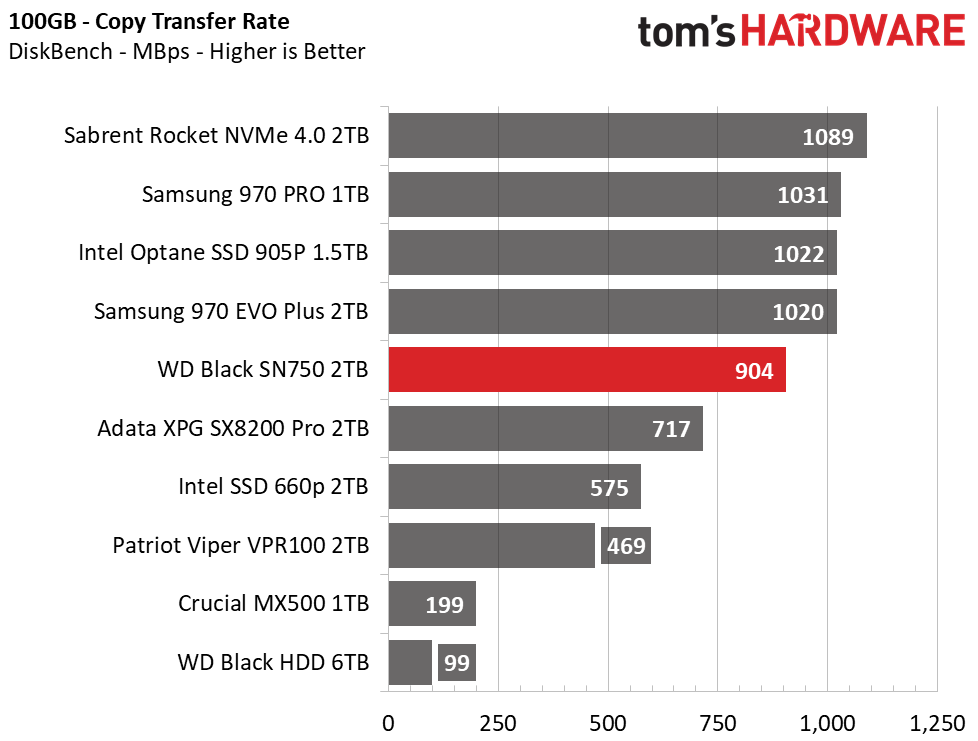
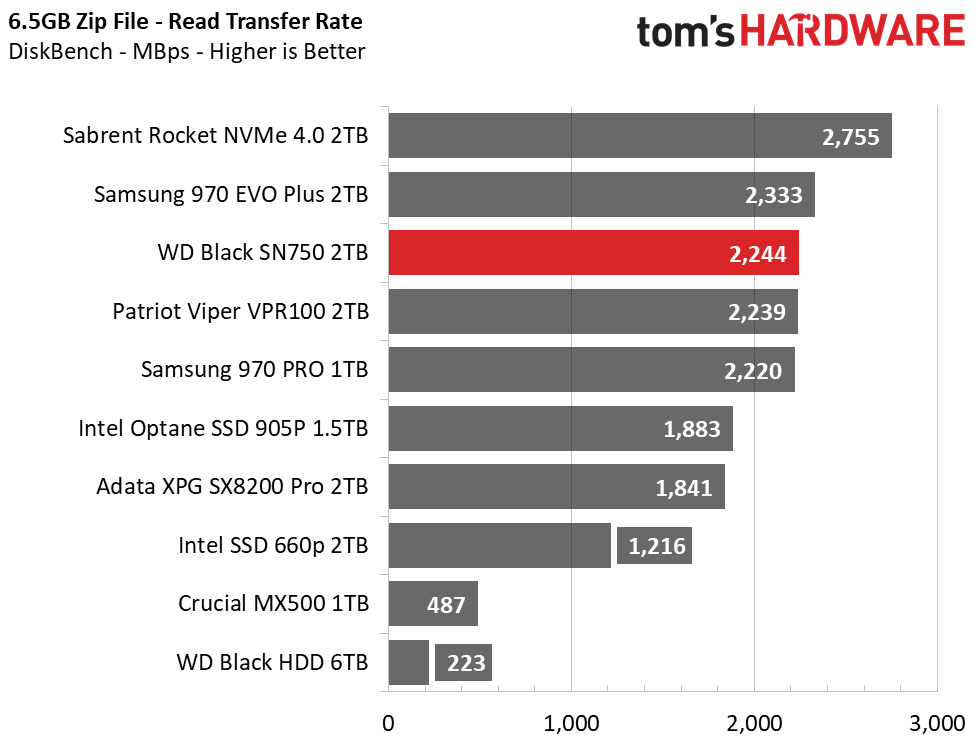
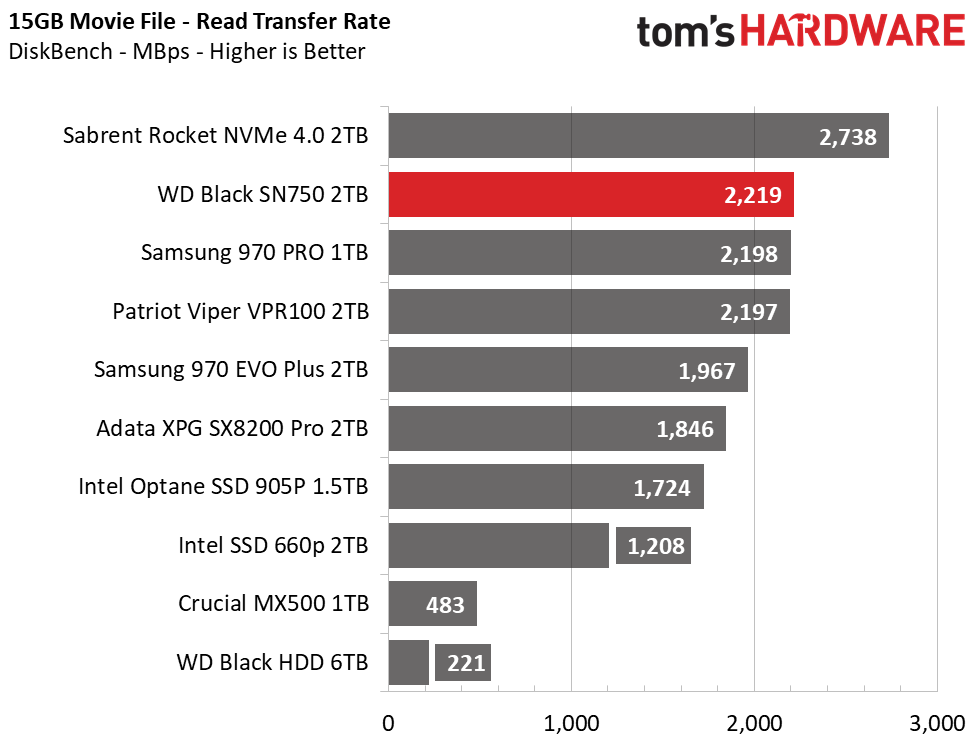
WD’s Black SN750 offers great consistency during file copy and writing operations, but it isn’t as tweaked for responsiveness with small files as some of its competitors. Both of the Samsung SSDs are faster, and Sabrent’s Rocket NVMe 4.0 gives a lot of bang for your buck with some of the fastest file transfer performance. Adata’s XPG SX8200 speeds past the WD Black SN750 during the 50GB file copy operation, but its sustained write performance lags behind the WD when we tax the drive with the intensive 100GB file copy task.
Trace Testing – PCMark 10 Storage Tests
PCMark 10 is a trace-based benchmark that uses a wide-ranging set of real-world traces from popular applications and common tasks to measure the performance of storage devices. The quick benchmark is more relatable to those who use their PCs lightly, while the full benchmark relates more to power users. If you are using the device as a secondary drive, the data test will be of most relevance.
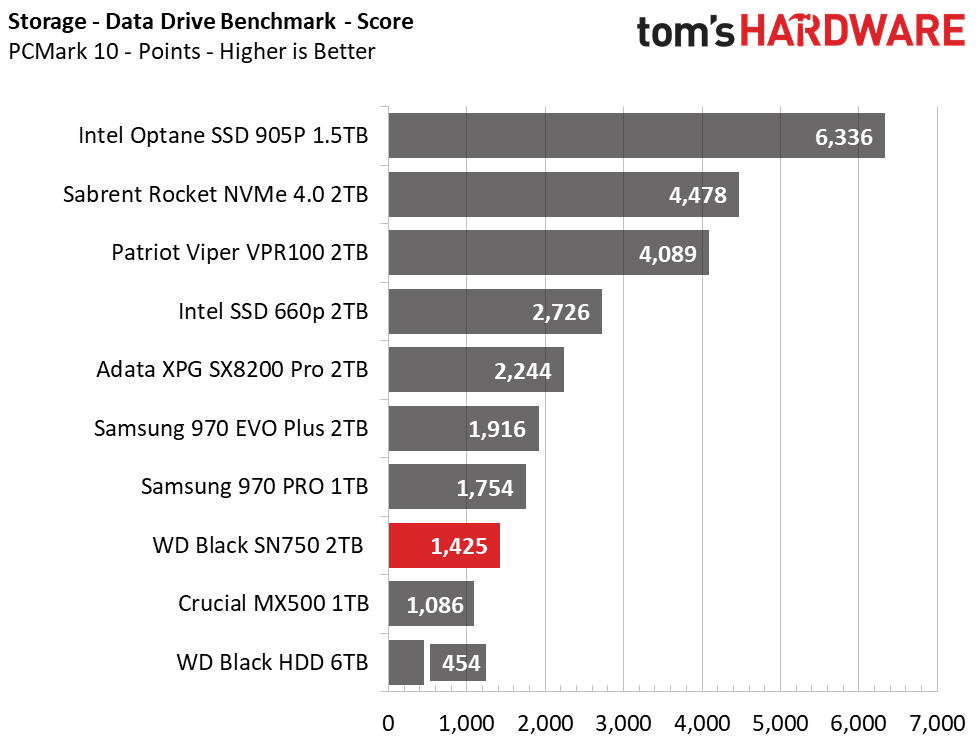
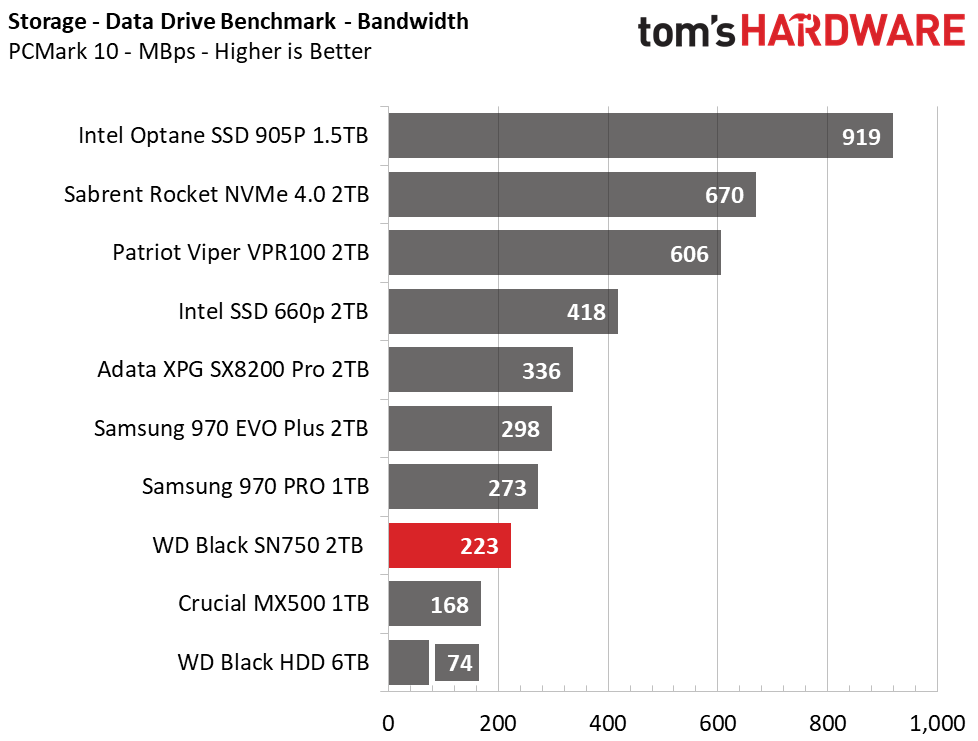
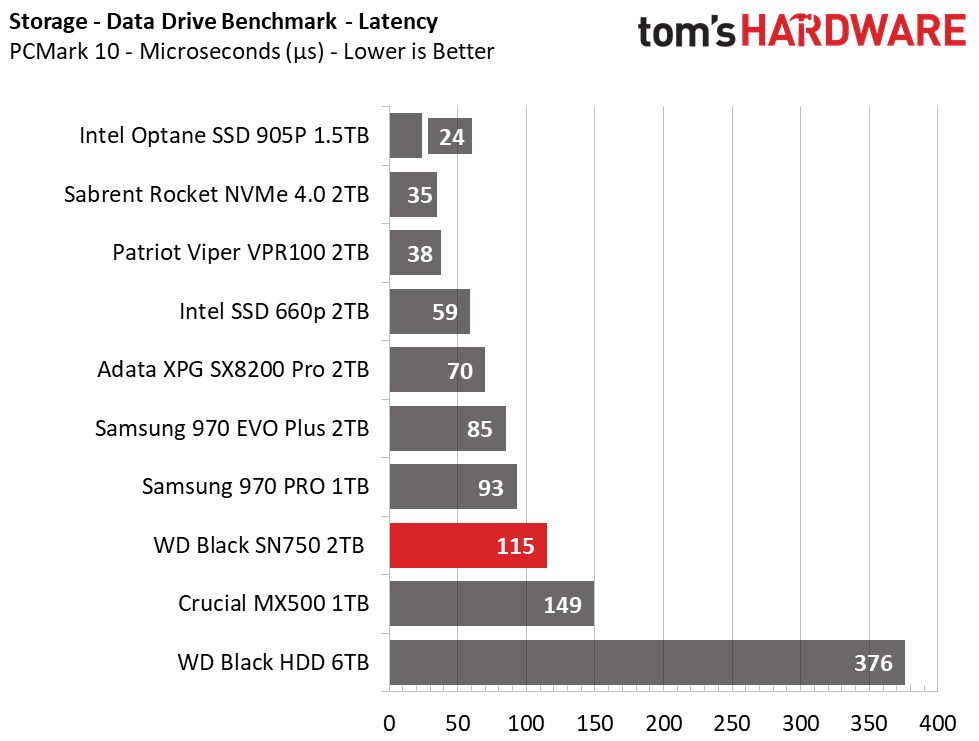
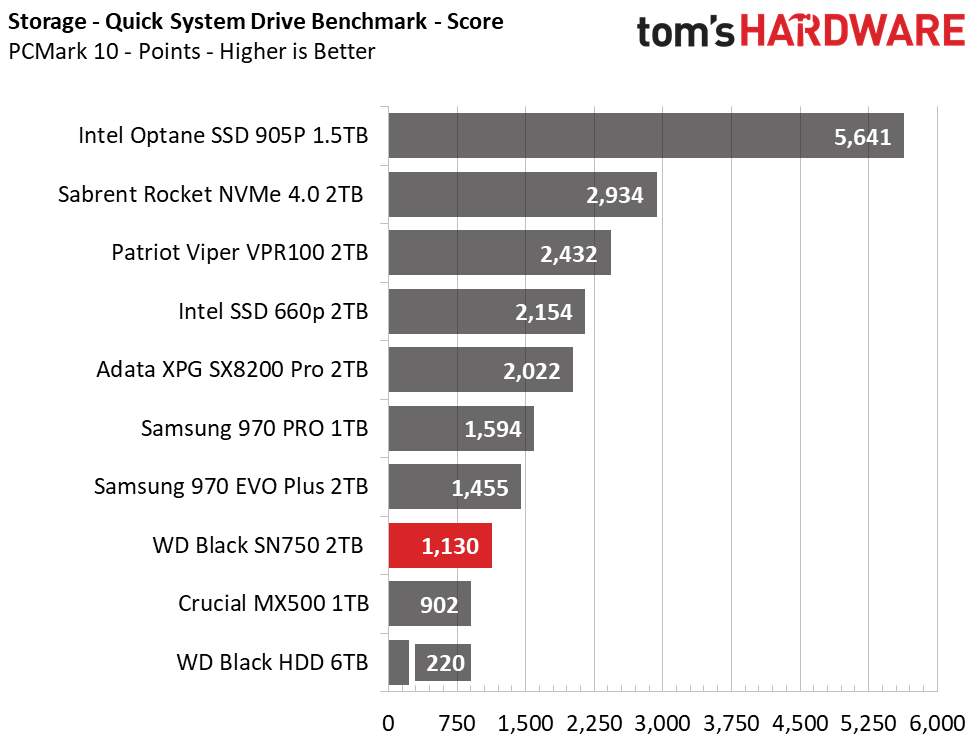
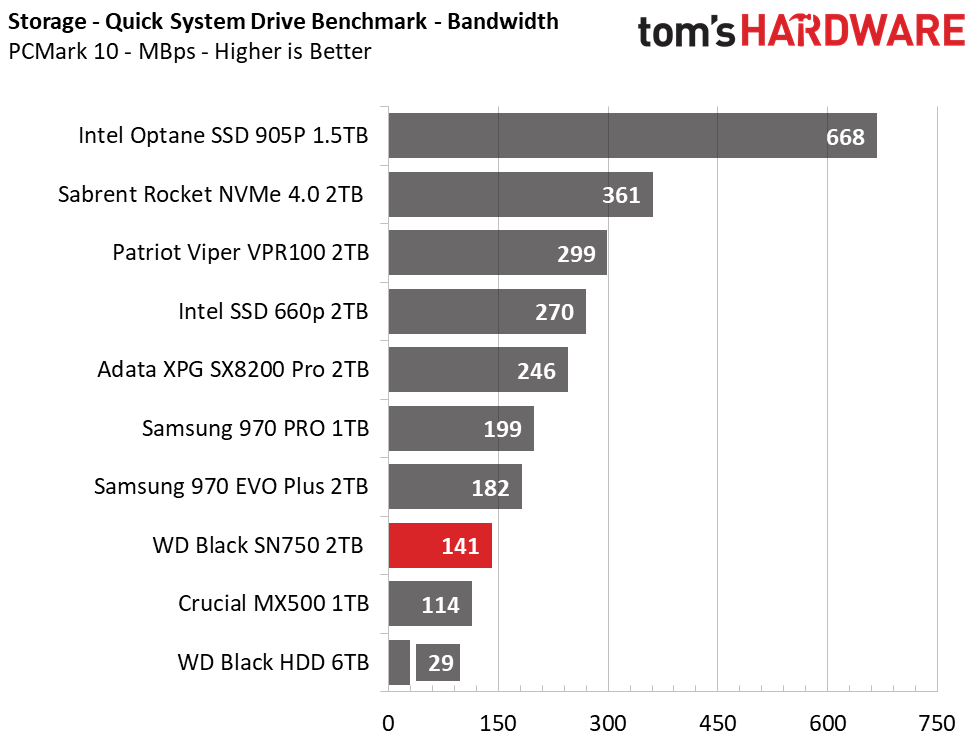
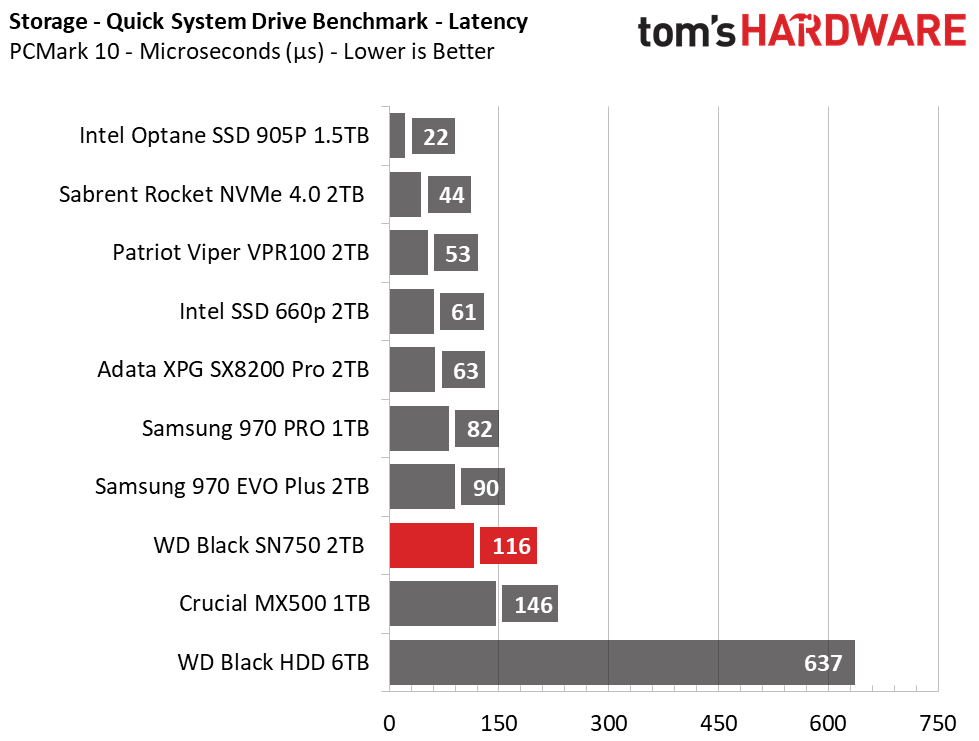
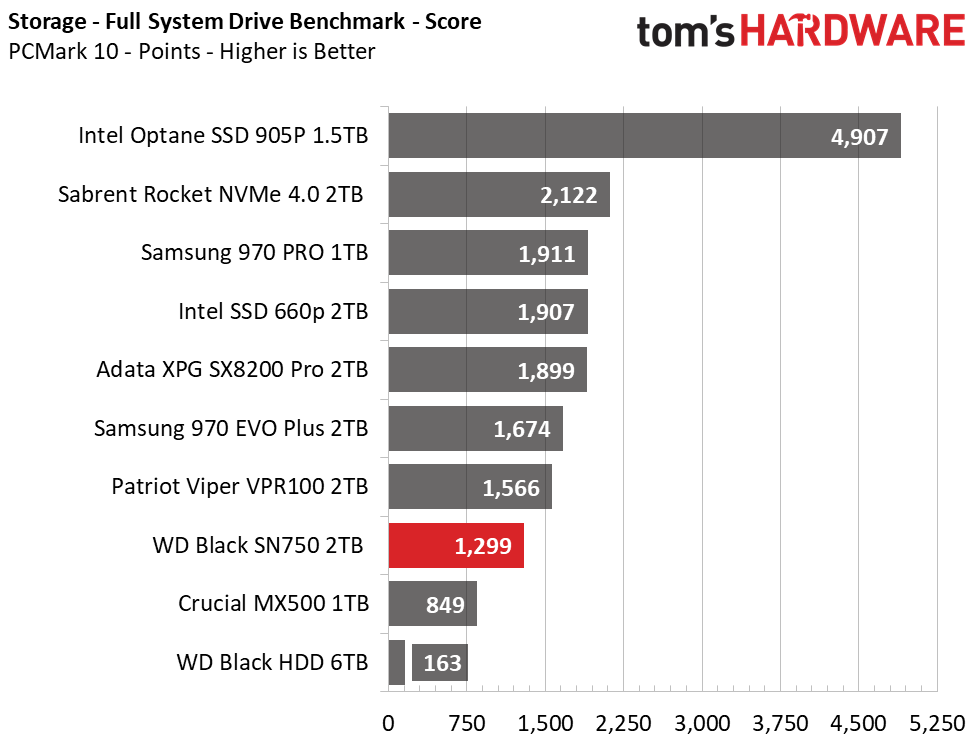
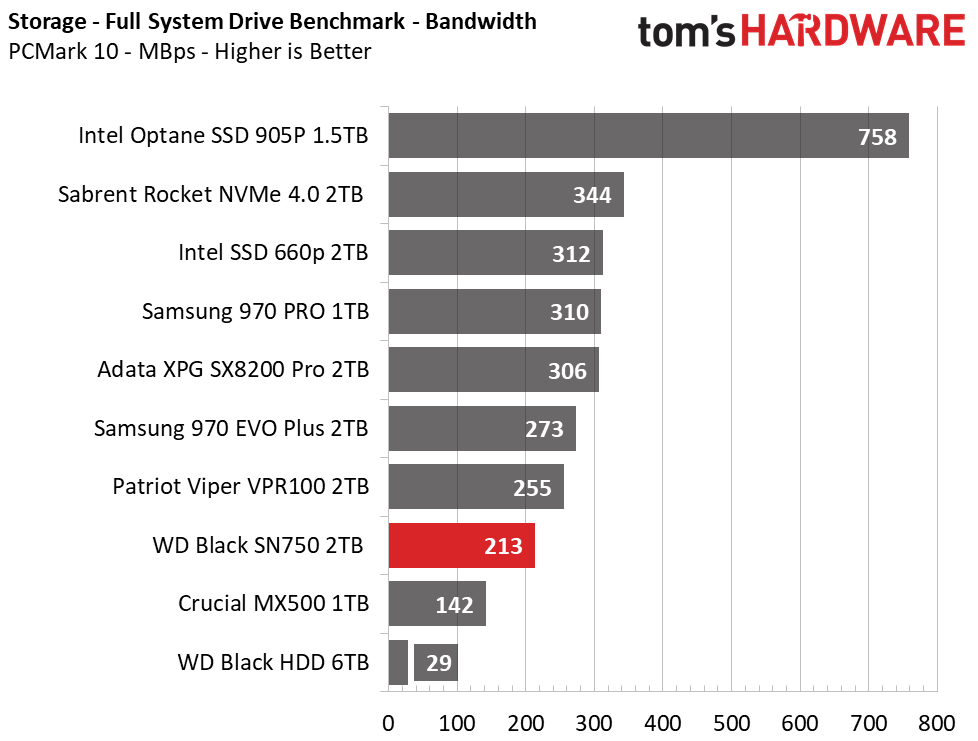
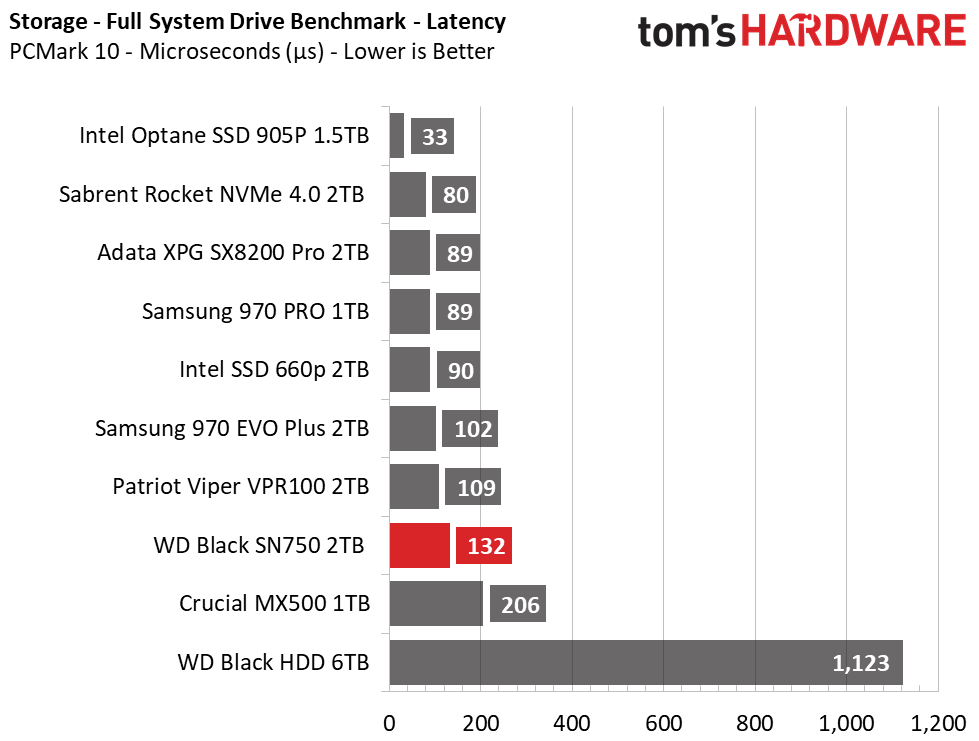
The WD Black SN750 shows its age during light workloads. The SN750 beats the Crucial MX500 and WD Black HDD due to its higher-bandwidth interface, but its responsiveness in random workloads lags behind direct competitors like the Samsung 970 EVO Plus, Adata XPG SX8200 Pro, and Sabrent Rocket NVMe 4.0. Unfortunately, this results in the SN750 falling into eighth place in each of the three PCMark 10 storage benchmarks. The SN750 is significantly more responsive than an HDD, but that’s an easy bar to beat.
Trace Testing – SPECworkstation 3
Like PCMark 10, SPECworkstation 3 is a trace-based benchmark, but it is designed to push the system harder by measuring workstation performance in professional applications.
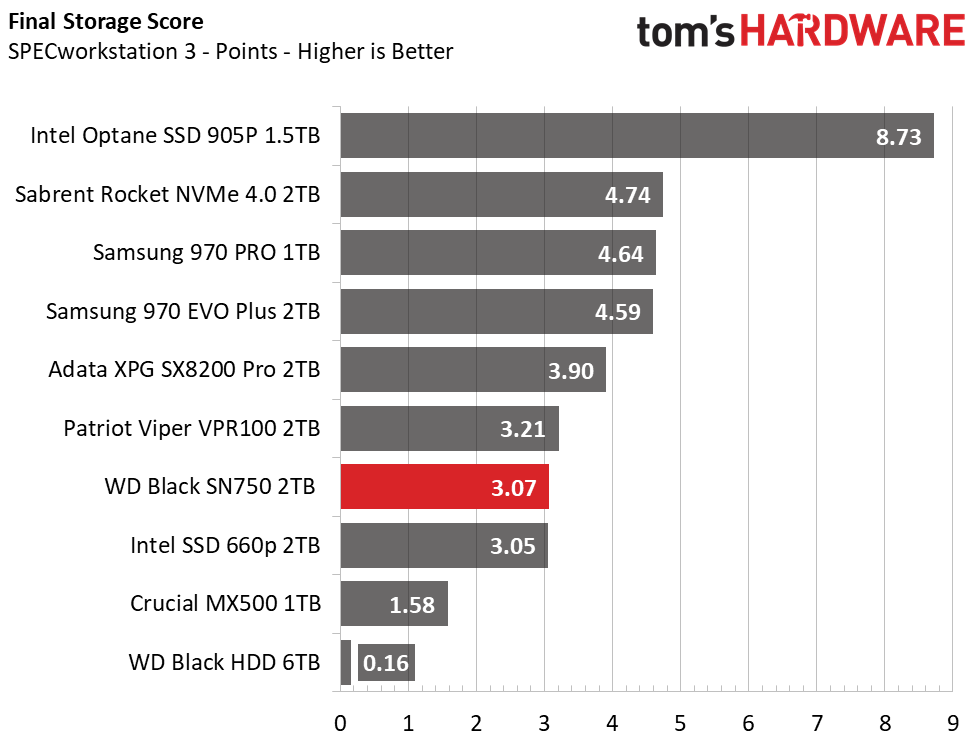
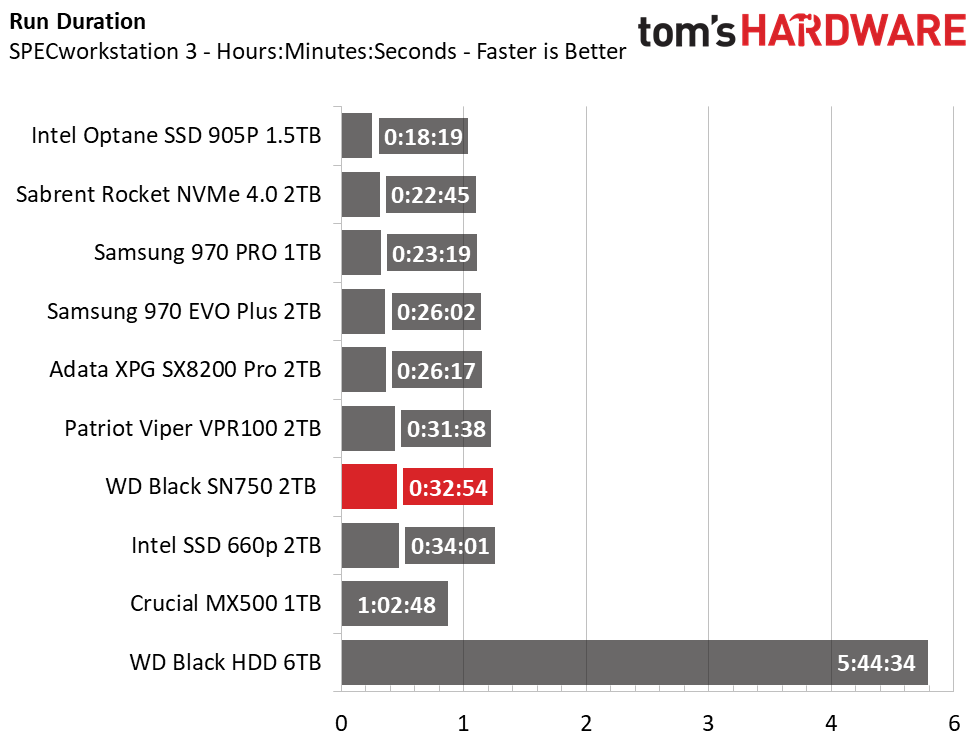
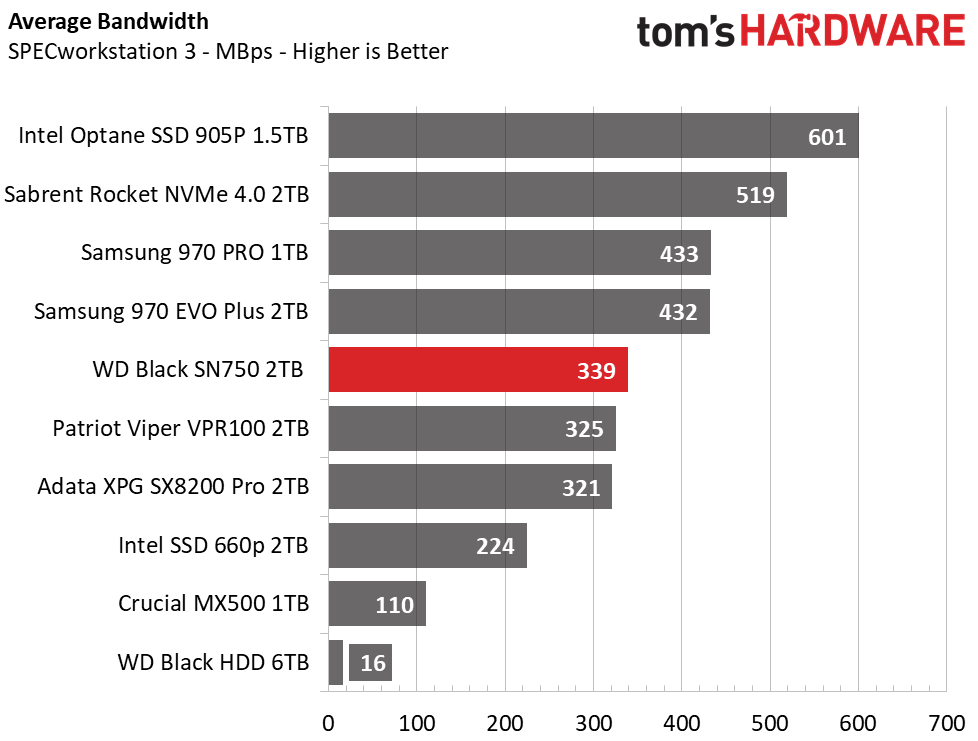
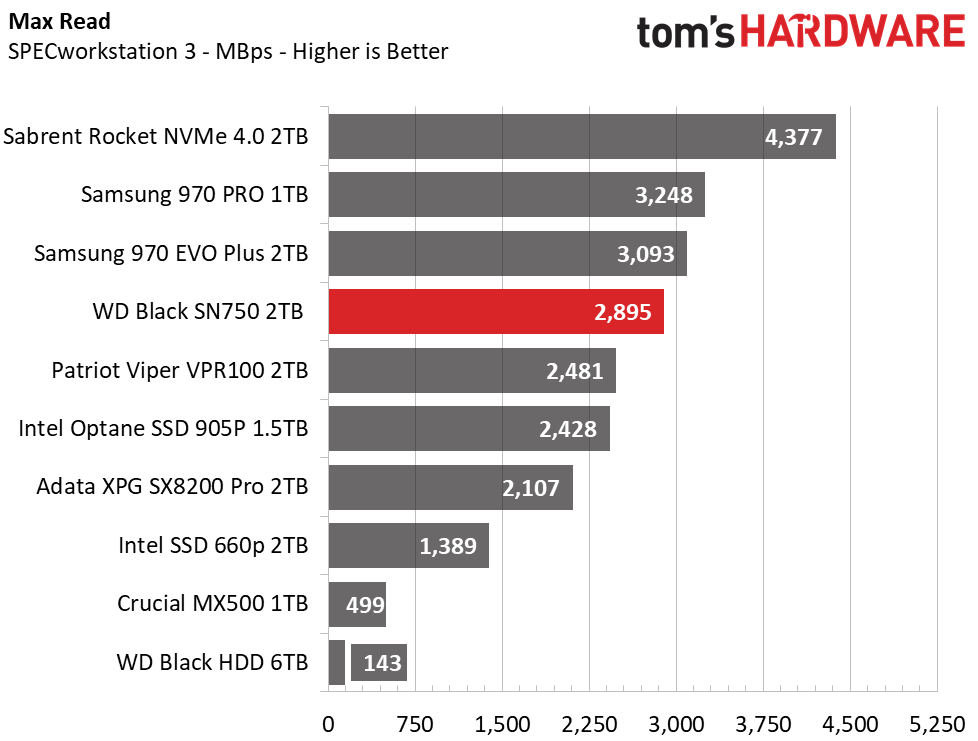
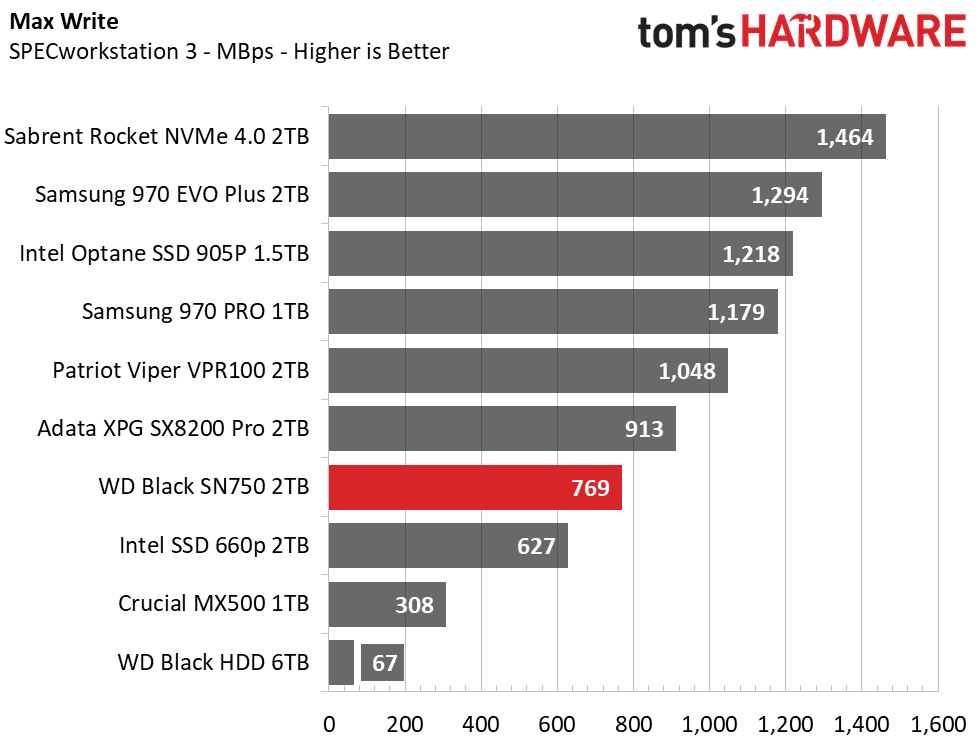
While an HDD can hold back a professional workflow, SSDs open up a whole new world for prosumers. The WD Black SN750 shaves hours off this test compared to the Black HDD, however, like with the PCMark 10 results, the WD Black SN750 lags behind its main competition in our SPECworkstation 3 application tests as it falls into seventh place. If you’re looking for the most responsive device for a prosumer application, you should opt for the much faster Intel Optane SSD 905P if you have room in the budget. If you’re a bit tighter on cash but need to speed up your workflow, the Sabrent Rocket or Samsung’s 970 series SSDs are a better value.
Synthetics - ATTO
ATTO is a simple and free application that SSD vendors commonly use to assign sequential performance specifications to their products. It also gives us insight into how the device handles different file sizes.
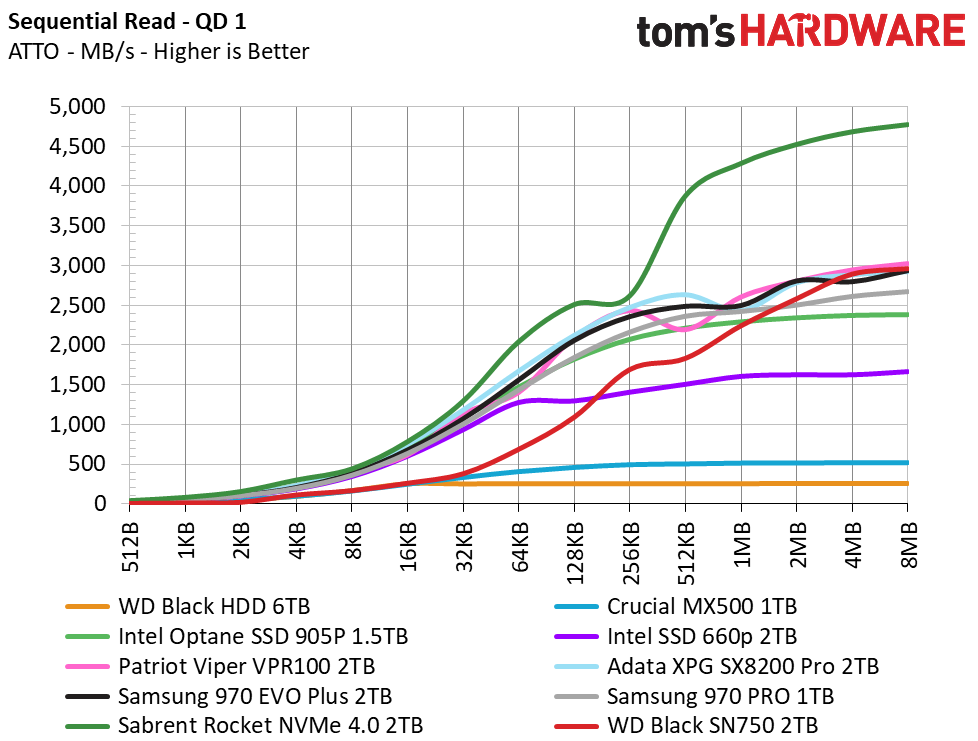
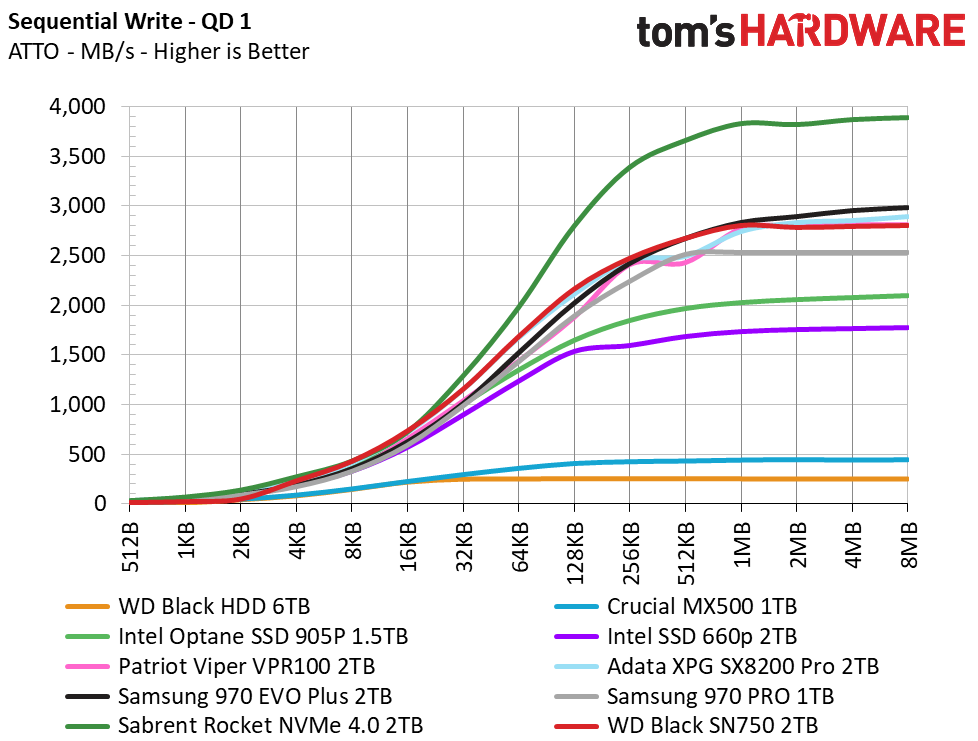
We tested the Black SN750 at a queue depth (QD) of 1, representing most day-to-day file access at various block sizes. As we have noticed in our application and real-world tests, the WD Black SN750 isn’t as responsive with small files as its competitors. The WD Black SN750’s read performance tied the SATA SSD until we reached a 32KB file size, but still, it can’t hang with most other NVMe SSDs. Write performance is much more responsive, however, nearly matching most competitors.
Synthetic Testing - iometer
iometer is an advanced and highly configurable storage benchmarking tool that vendors often use to measure the performance of their devices.
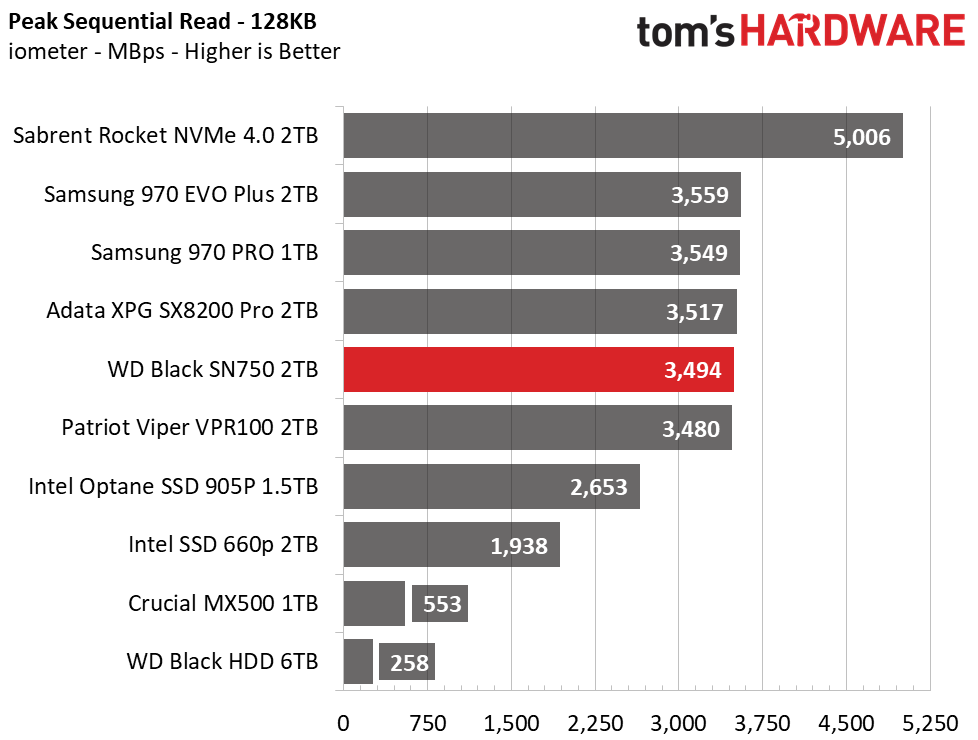
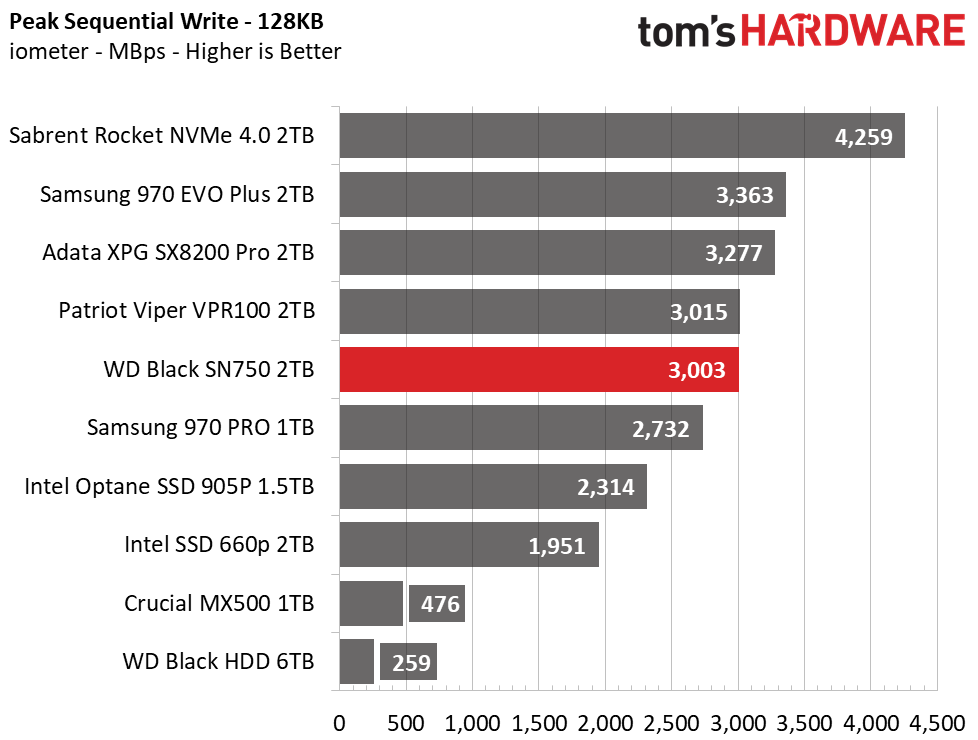
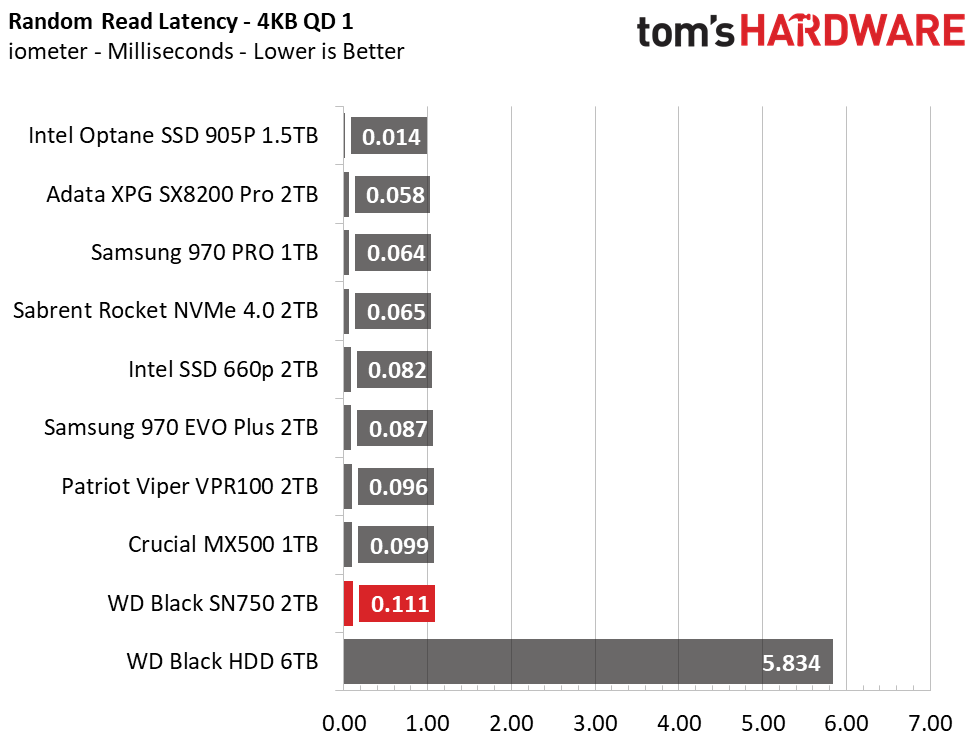
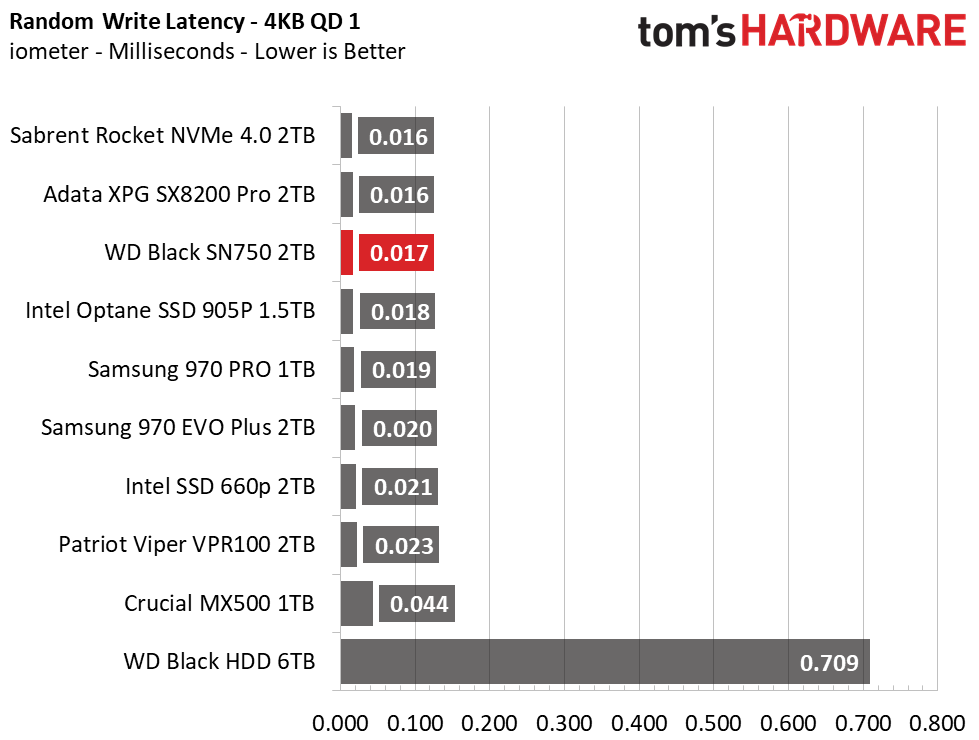
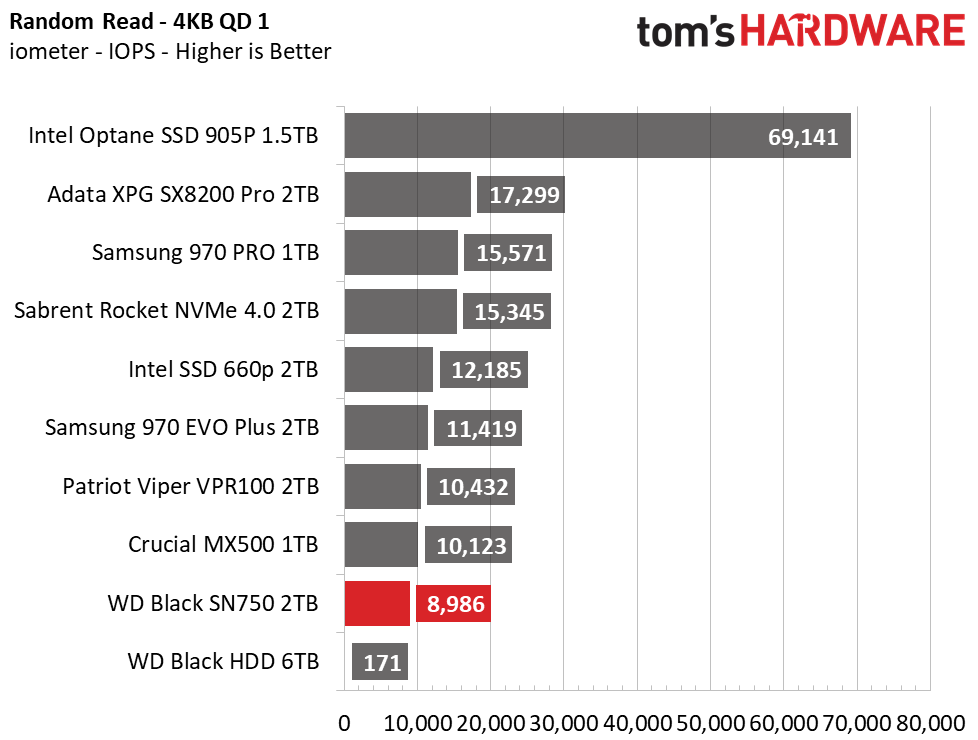
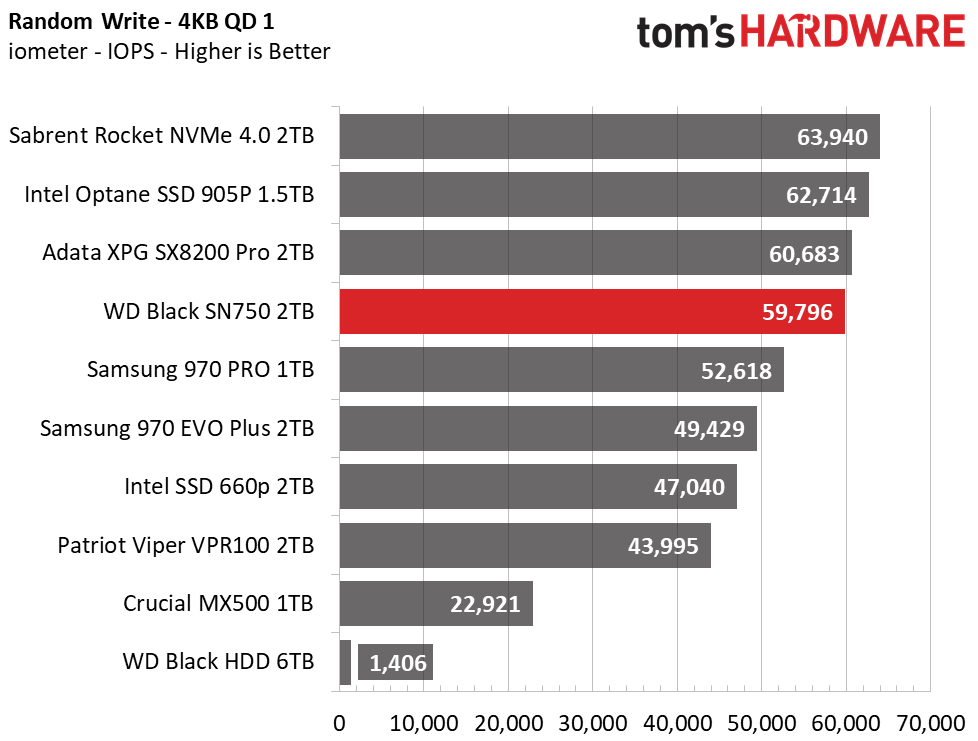
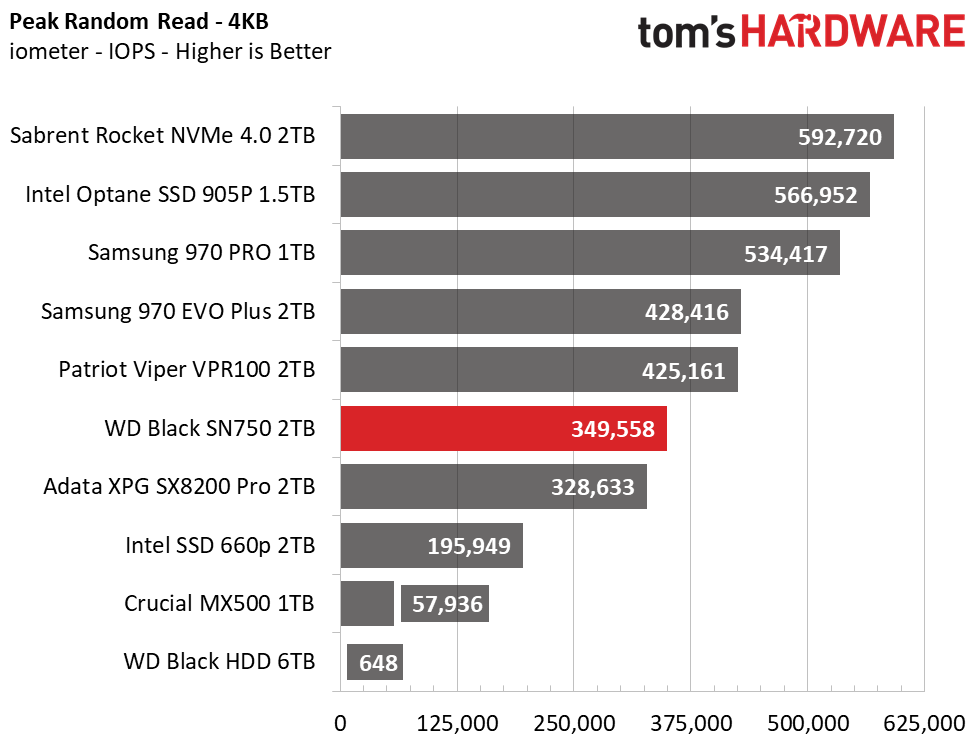
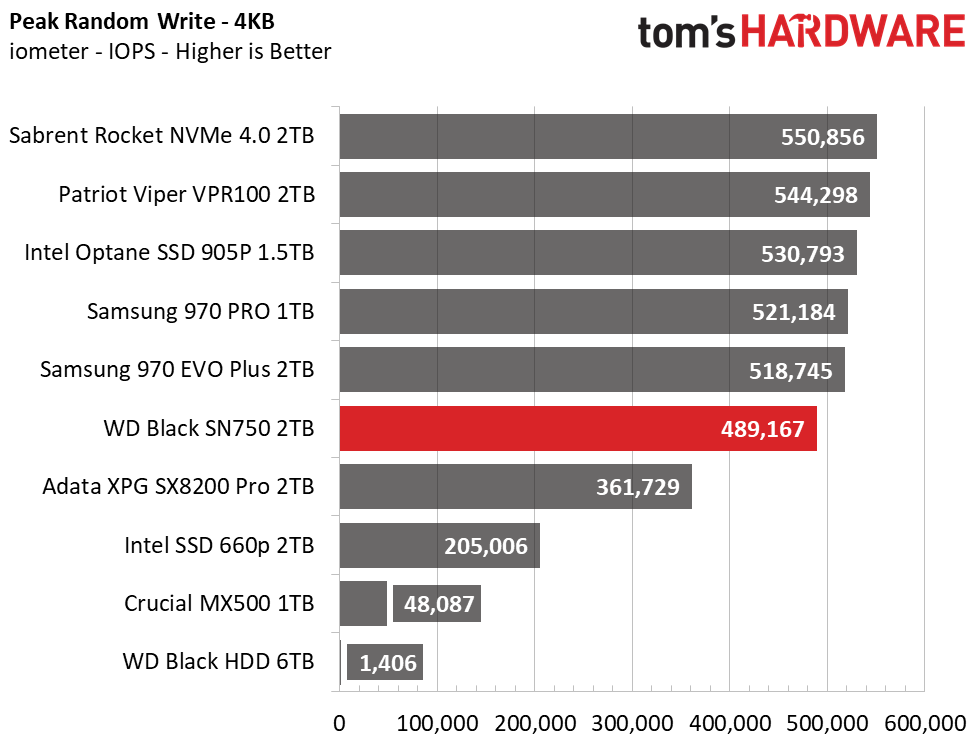
As expected, the SN750’s sequential read/write performance peaks at about 3.5 / 3.0 GBps, but random read performance is lacking. The Black SN750 is less responsive than even the Crucial MX500, but its write performance is about average compared to most of the fastest drives. This partially explains why the WD lags in most applications, but it’s part of the trade-off required for better sustained sequential write performance, which we cover next.
Sustained Write Performance, Cache Recovery and Temperature
Official write specifications are only part of the performance picture. Most SSD makers implement a write cache, which is a fast area of (usually) pseudo-SLC programmed flash that absorbs incoming data. Sustained write speeds can suffer tremendously once the workload spills outside of the cache and into the "native" TLC or QLC flash. We use iometer to hammer the SSD with sequential writes for 15 minutes to measure both the size of the write cache and performance after the cache is saturated. We also monitor cache recovery via multiple idle rounds.
When possible, we also log the temperature of the drive via the S.M.A.R.T. data to see when (or if) thermal throttling kicks in and how it impacts performance. Bear in mind that results will vary based on the workload and ambient air temperature.
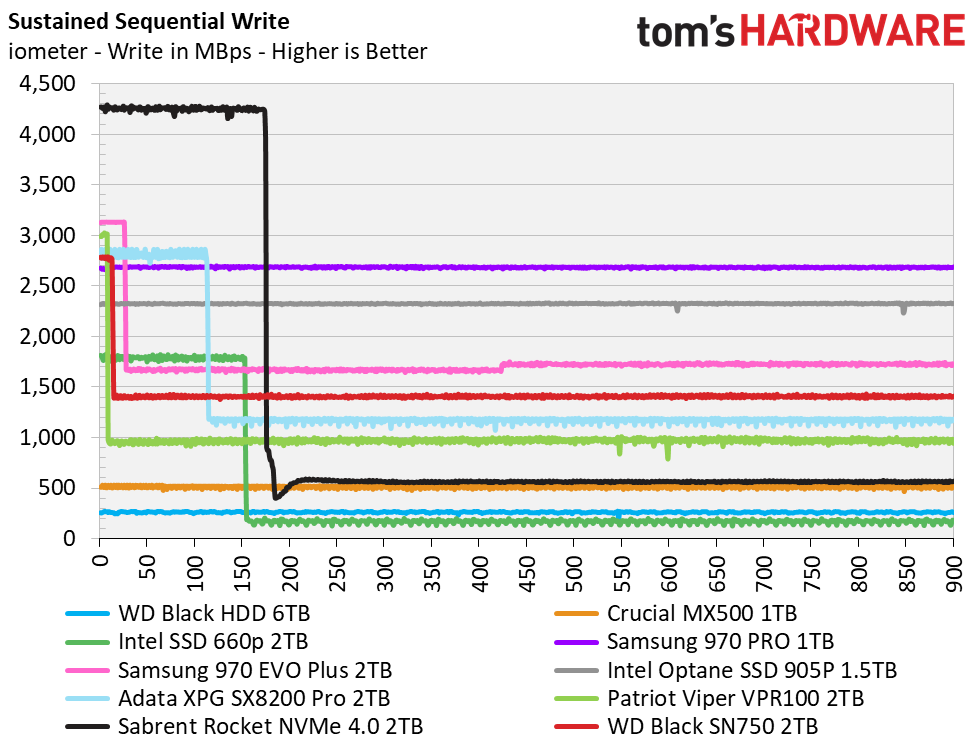
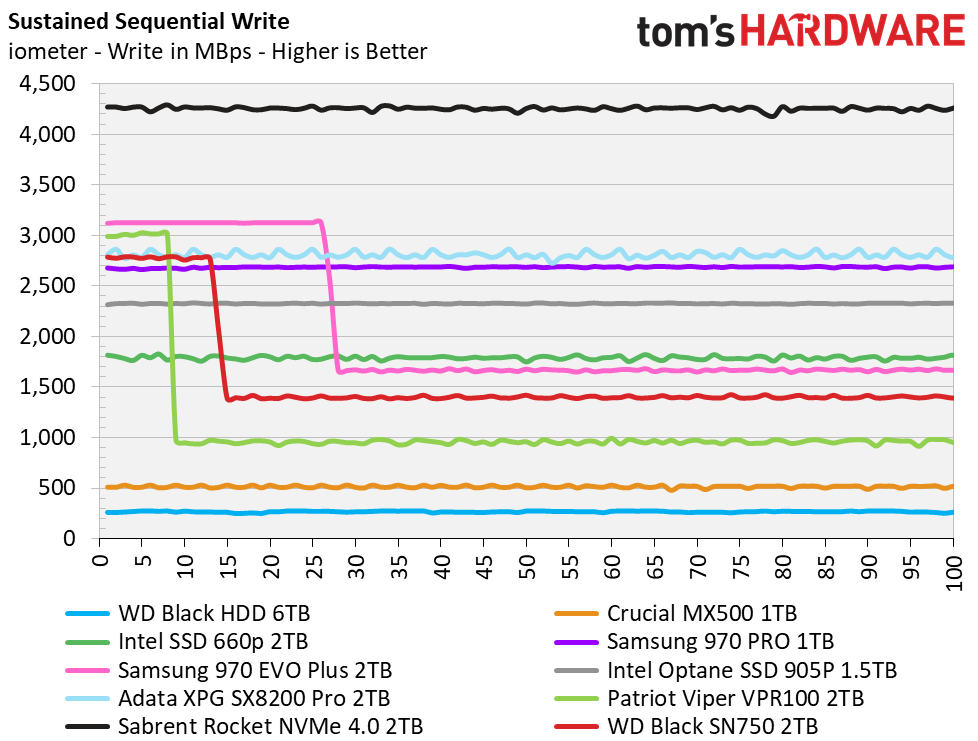
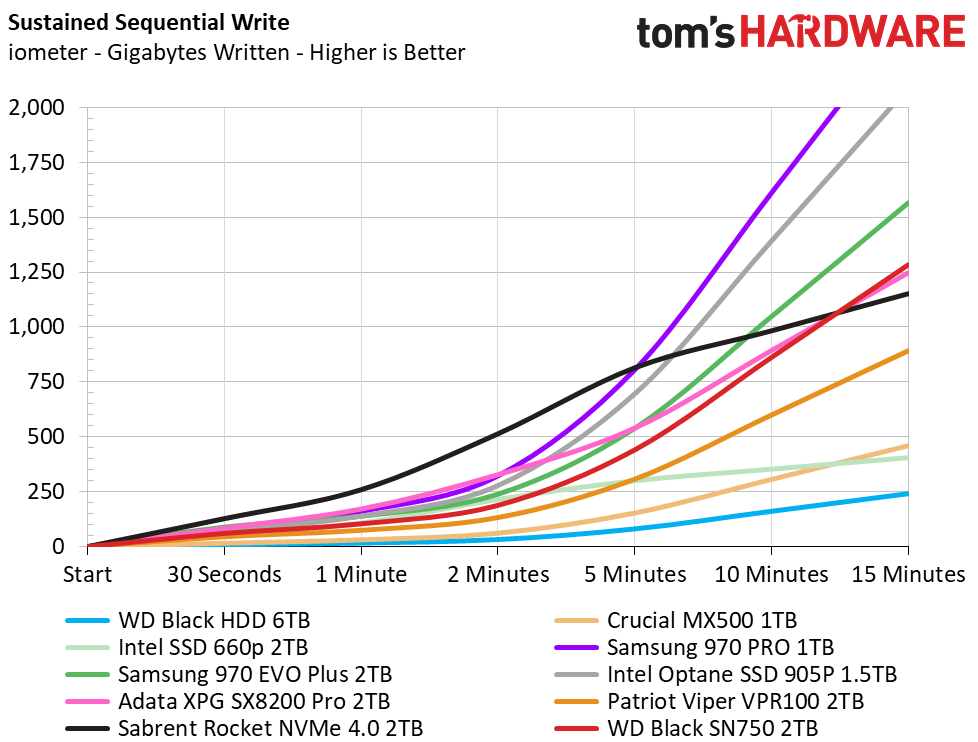
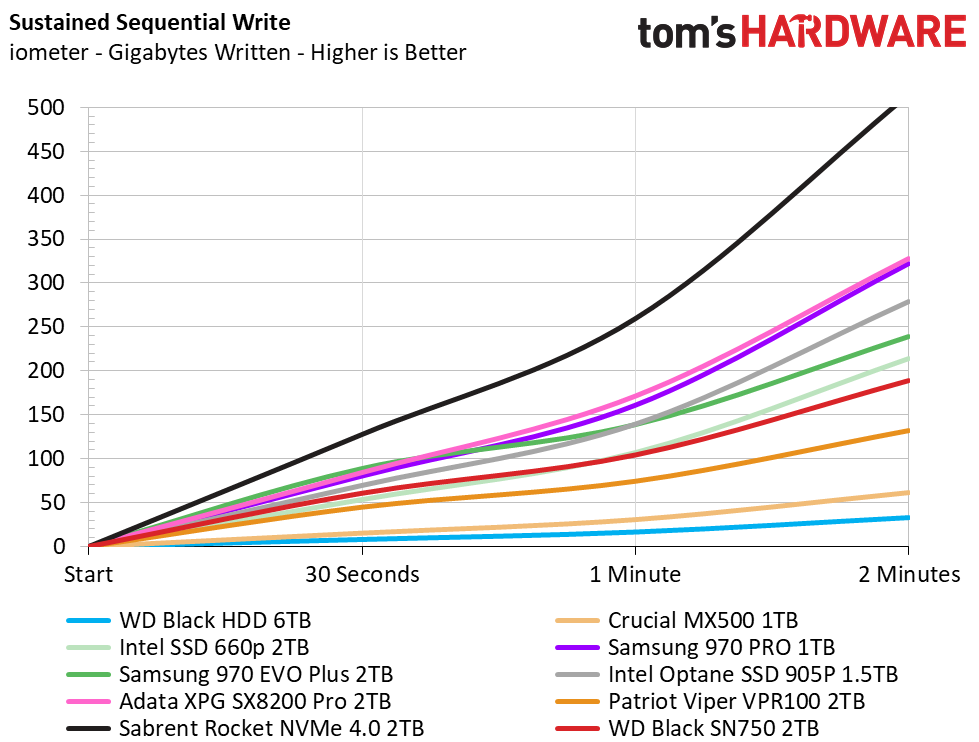
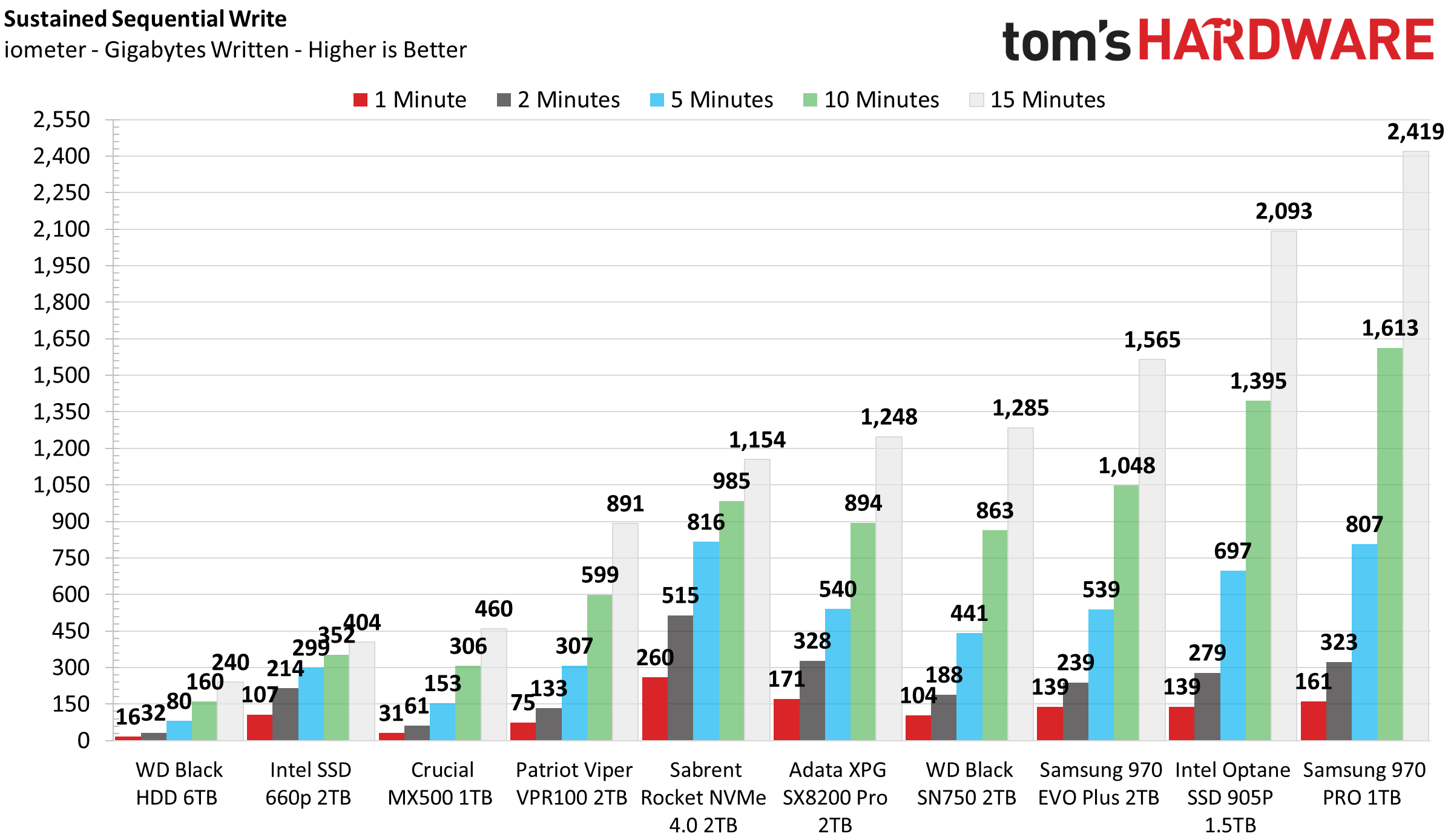
During heavy sustained write workloads, the Black SN750 is one of the faster and more consistent SSDs we’ve tested. Much like the Adata XPG SX8200 Pro, it writes at 2.8 GBps for the first 36GB of the test, but performance degrades to an average of about 1400 MBps once the workload saturates the cache. That’s 200 MBps slower than the 1TB model. The 2TB model features a static 36GB write cache (22GB more than the 1TB model), which helps it recover very quickly after the writing stops. After a mere 30 seconds, the drive is ready for more work.
The SN750’s heat output is typically acceptable during most daily usage with no airflow, although it’s a bit warm at idle compared to most other SSDs. We hammered it with a few hundred GB of data at once, however, and thermal throttling kicked in when the controller hit 80 degrees Celsius. We recommend throwing the drive under a heatsink, or at minimum giving it some airflow, if you use it in heavy prosumer-class applications.
Power Consumption
We use the Quarch HD Programmable Power Module to gain a deeper understanding of power characteristics. Idle power consumption is a very important aspect to consider, especially if you're looking for a new drive for your laptop. Some SSDs can consume watts of power at idle while better-suited ones sip just milliwatts. Average workload power consumption and max consumption are two other aspects of power consumption, but performance-per-watt is more important. A drive might consume more power during any given workload, but accomplishing a task faster allows the drive to drop into an idle state faster, which ultimately saves power.
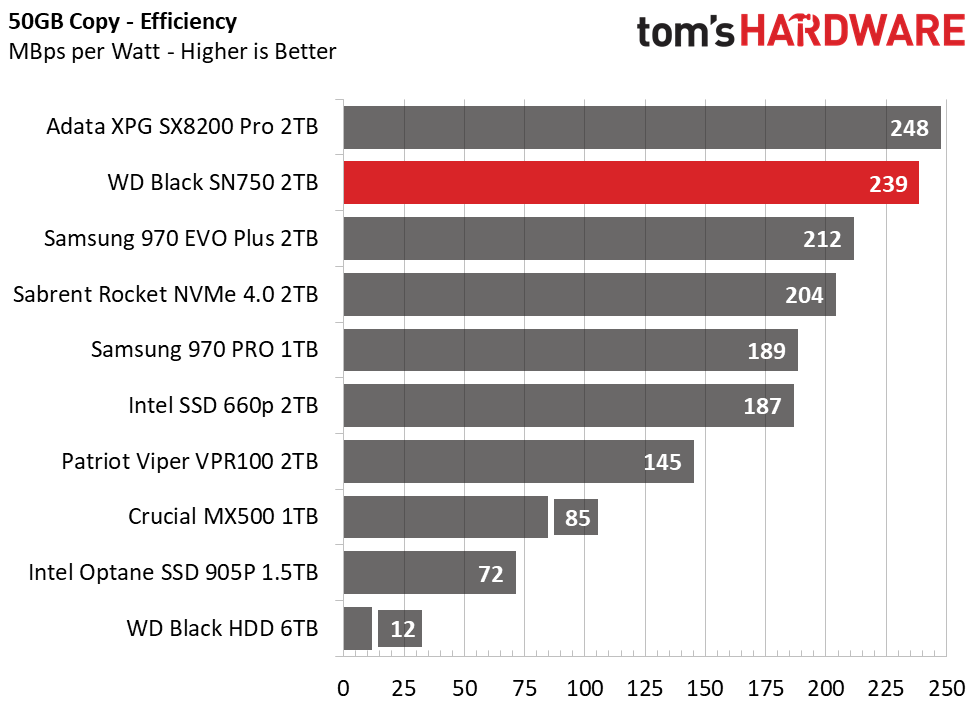
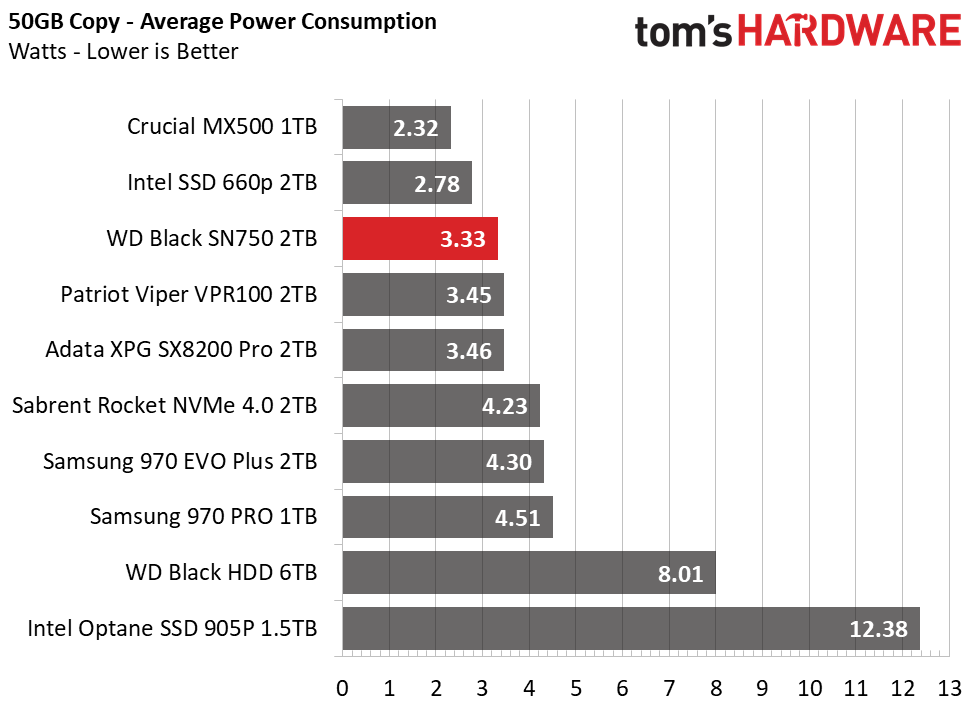
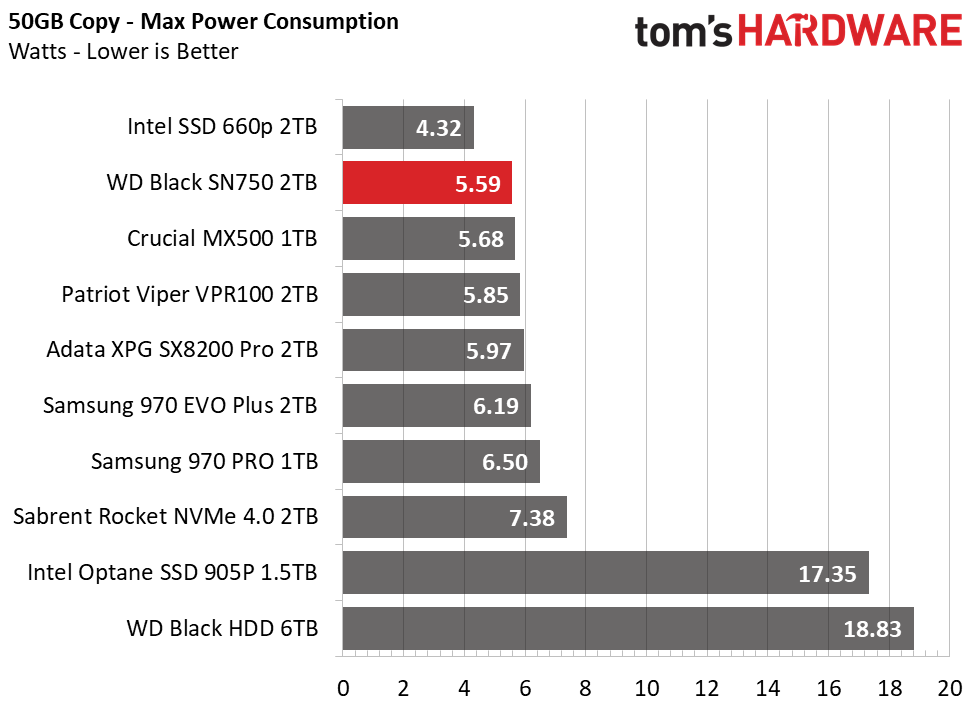
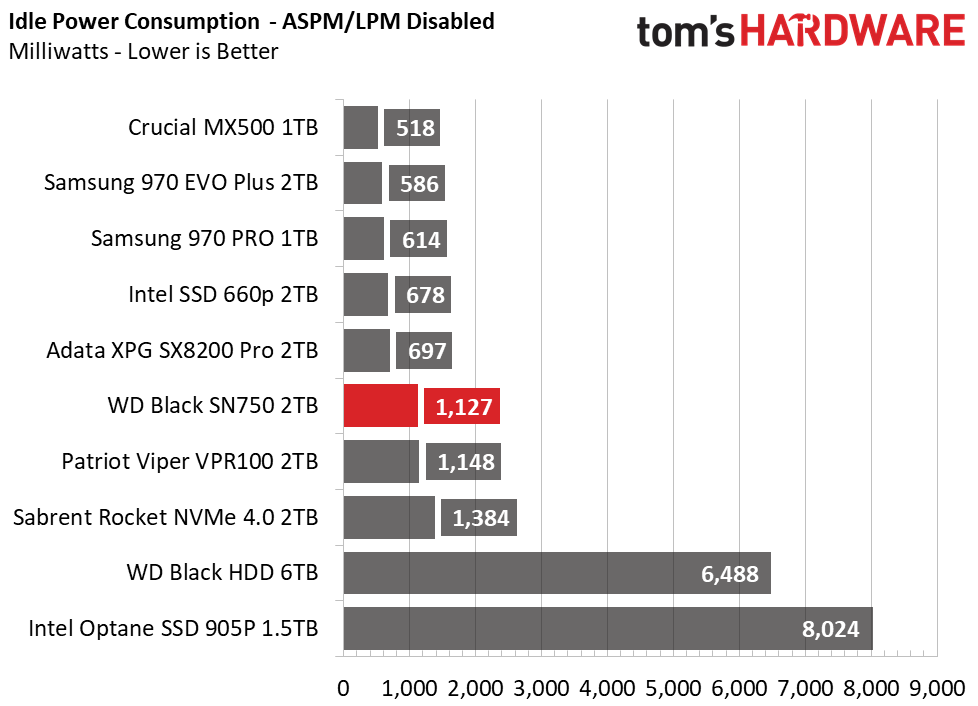
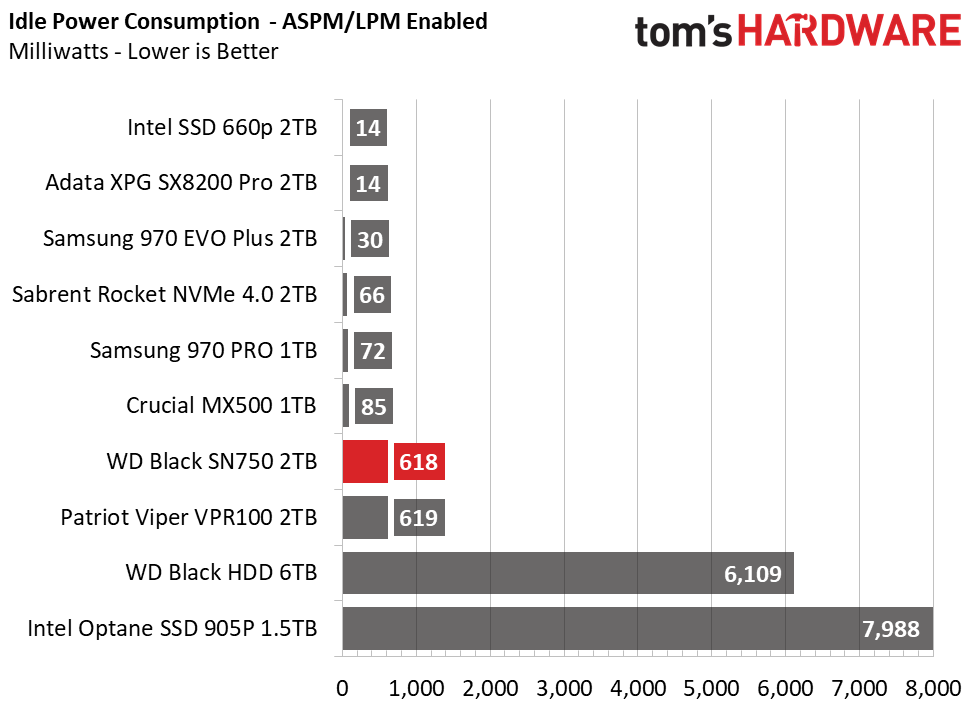
The Black SN750 is not only consistent, but it is also very power efficient under load. Average and maximum power consumption ranks second overall, falling just a few MBps-per-watt behind the Adata XPG SX8200 Pro. The SN750 is also more efficient than the Samsung 970 EVO Plus at the same task. However, while it supports multiple low power states, the SN750’s idle power consumption is significantly higher than competing SSDs.
MORE: Best SSDs
MORE: How We Test HDDs And SSDs
MORE: All SSD Content
Stay On the Cutting Edge: Get the Tom's Hardware Newsletter
Get Tom's Hardware's best news and in-depth reviews, straight to your inbox.

Sean is a Contributing Editor at Tom’s Hardware US, covering storage hardware.
-
jstanleydodson So this drive beats the 1TB 970 Evo in performance, yet it is priced to high? I think it is priced perfectly given that it beats the Evo.Reply -
jimmysmitty Gaming mode on an SSD. Seems as useful as the turbo button on late 80s/early 90s PCs.Reply -
NinjaNerd56 I bought one of these 2 years ago for a NUC server I was building.Reply
Yes, it ran 24 x 7 at 99% for 26 months but imagine my HAPPINESS when it went tits up at Xmas without warning.
It’s golden brown, as in toast. The Samsung in another machine that’s 4.5 years old?
Still kicking ass...
YMMV, WAC, WSL...... -
elbert WD manufactors their own Hard Drives and for those you can trust today. I would say reliability and over priced on the black edition. Pretty much all hard drives tho are over priced today. Now these SSD's aren't manufactured by WD and even if they were I would have a real worry of their reliability. Performances matters not when its low grade parts so I wouldn't pay nearly as much for those as say Samsung's or Crucial that have a proven track record in the SSD market.Reply -
poodie13 Yes, I would agree "... handcrafted ..." is a ridiculous description of a mass production sub-component. Even for a "designer case" these days that would sound silly.Reply
And "...and an updated military-style font..."
- Too much Marketing-Speak in this article but I it is just a trade announcement.
: but we'll have to wait for it to pass through the lab to verify those claims : -
BaRoMeTrIc Reply
Yeah they should have gone SLC and just stacked the flash on top of each othervplatson said:Same crappy TLC NAND. Skip...